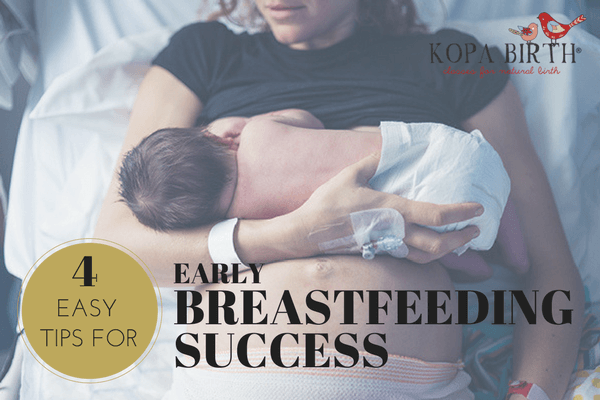
Estimated reading time: 5 minutes
Your baby will likely begin breastfeeding within the first few minutes of being born. The next days and weeks that follow are formative, and can set you up for a positive long-term nursing relationship. Consider following these 4 easy tips for early breastfeeding success!
A woman’s body releases a variety of hormones that regulate labor, birth, and breastfeeding. These hormones include oxytocin, endorphins, catecholamines, and prolactin. The production of these hormones have been found to sharply increase around the time when labor begins on it’s own (1).
For example, prolactin plays a role in the creation of breast milk. Studies suggest that there is a large increase in prolactin receptors the day before labor begins spontaneously (2). When labor begins on its own, the levels of prolactin are more likely to be at an optimal level. This may make nursing easier and more successful.
Skin-to-skin contact is when mom places the unclothed baby directly on her skin. This simple act has been proven to promote attachment and bonding between mom and baby (3). With such strong evidence, skin to skin contact directly after birth has become the norm at most hospitals.
Not surprisingly, the benefits of skin-to-skin contact extend to early breastfeeding as well. Babies are born with the instinct to breastfeed. When placed skin-to-skin after birth, babies are able to find mom’s breast and latch on to begin nursing without any assistance (4). Also, moms who hold their newborns skin-to-skin following delivery are more likely to still be nursing their babies 4 months after birth (3).

Breastfeeding on demand is known by a variety of titles, including “baby-led” feeding and “feeding on cue.” They all refer to the same principle: Breastfeed your baby when he or she shows signs or cues of hunger. These cues may include hand to mouth movement, rooting, fidgeting, or even the late indicator of crying (5). This principle stands in contrast to the idea that moms should follow a rigid feed schedule and breastfeed according to the clock.
One compelling reason to breastfeed on demand is milk supply. Breastfeeding is a demand/supply system in which breast milk production increases as the baby’s demand increases (6). Feeding on demand allows a baby to nurse often and liberally. This gives mom and baby the best chance for a generous milk supply (7).

It’s wise to expect some discomfort in the first few weeks of breastfeeding. In fact, 80-90% of nursing women experience some degree of nipple soreness (8). Yet unfortunately, moms are often told that if breastfeeding hurts, they’re doing it wrong. These types of comments can lead to discouragement. Not surprisingly, nipple pain is the most common reason moms give for ending breastfeeding (9).
Let’s be real. Most of us aren’t used to our nipples being forcefully sucked on for hours each day. The pain associated with early breastfeeding typically goes away in a few weeks. If the discomfort persists pasts the first 2 or 3 weeks, don’t despair! Reach out to a qualified lactation consultant, and possibly an ENT. It may be that you need some help learning how to get a good latch. Or, baby might have a tongue tie, lip tie, or some other functional barrier to pain-free breastfeeding. Fortunately, most of these challenges can be overcome with some short-term professional help.
Nursing offers a multitude of benefits for your baby, yet sometimes early breastfeeding can get off to a rocky start. Remember to try and let labor start on it’s own. At birth, encourage skin-to-skin contact with baby. Always try to breastfeed your baby on demand. And if you experience nipple pain, know that it will likely go away soon. Here’s to setting yourself up for a positive early breastfeeding experience!!
Kopa Birth’s online birthing classes allow you to prepare for natural childbirth in the comfort of your own home, 24/7. Enroll today in our free online childbirth class to learn more about preparing for natural childbirth.
References:
(1) Amis, D. (2014). Healthy Birth Practice #1: Let Labor Begin on Its Own. The Journal of Perinatal Education, 23(4), 178–187. http://doi.org/10.1891/1058-1243.23.4.178
(2) Buckley S. (2014). The hormonal physiology of childbearing. New York, NY: Childbirth Connection.
(3) Moore, E.R., Anderscon, G.C., Bergman, N. (2007). Early skin-t0-skin contact for mothers and their healthy newborn infants. Cochrane Database Syst Rev. July 18;(3):CD003519.
(4) Phillips, R. (2013). Uninterrupted Skin-to-Skin Contact Immediately After Birth. Newborn & Infant Nursing Reviews. 13(2): 67-72.
(5) Iwinski, S. (2003). Feeding On Cue. New Beginnings, Vol. 20 No. 4, July-August, p. 126.
(6) Watson, R.R., Grimble, G., Preedy, V.R. (2013). Nutrition in Infancy: Volume 1. Springer Science + Business Media, New York, NY. pg. 250.
(7) Marasco, L. (1998). Common Breastfeeding Myths. Leaven, Vol 34 No. 2, April-May, pp. 21-24.
(8) Huml, S. (1995). Cracked Nipples in the Breastfeeding Mother. Advance for Nurse Practitioners. April.
(9) Kent, J. C., Ashton, E., Hardwick, C. M., Rowan, M. K., Chia, E. S., Fairclough, K. A., … Geddes, D. T. (2015). Nipple Pain in Breastfeeding Mothers: Incidence, Causes and Treatments. International Journal of Environmental Research and Public Health, 12(10), 12247–12263. http://doi.org/10.3390/ijerph121012247
Your baby will likely begin breastfeeding within the first few minutes of being born. The next days and weeks that follow are formative, and can set you up for a